
Curriculum Outline
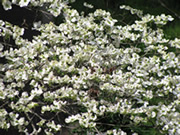
Our dogwood tree blooms in April
As JDS fellows join our Program in Environmental Sciences for a master's degree, they engage in not only thesis research but also a number of course work that intends to broaden and deepen their knowledge and analytical skills. As environmental policies can be related to a large number of scholarly fields, the fellows may choose the following options for the entire course of their degree education.
Special Educational Activities for JDS fellows
In addition to existing environmental sciences courses, the Program of Environmental Sciences has designated a special committee that provides tailor-made educational activities for the fellows. Activities include regular symposiums or seminars as well as field excursions. The detailed descriptions of the past activities are listed under the "Academic Activities" menu bar of this website. In joining these activities, they can deepen their knowledge about not only environmental policy-related practices but also Japanese culture and history.
SUSTEP Certificate Program for the Next Global Environmental Leaders
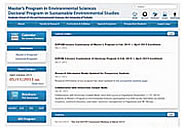
Environmental Sciences Website
http://www2.envr.tsukuba.ac.jp/eng/
Once admitted, JDS Fellows have an opportunity to register for the SUSTEP(Sustainability Science, Technology, and Policy) certificate program. The SUSTEP Program aims to foster global leaders, who are highly trained in science/technology, humanity/social sciences, and diplomacy/leadership. This program is managed under the Master's Program in Environmental Sciences and offers a unique set of expert training courses. It is designed for educating both Japanese and international students. The SUSTEP Program has four "major" fields to choose. SUSTEP certificates will be given to those students who acquired more than 8 credits from SUSTEP designated courses, and submits master's thesis in English that is related to the SUSTEP concept.
| (1) | Water Environment & Disaster Management This major fosters experts in conservation and restoration of the water environment as well as the maintenance or restoration of secure infrastructure against climate change challenges. Students can acquire advanced scientific and technological knowledge about the watershed environment through courses on field surveys, disaster analysis, theory, and numerical simulations. |
| (2) |
Biodiversity Conservation This major provides courses on the basic mechanisms of ecosystems, soil science, microbiology, and analytical chemistry. These courses help refine analytical skills that may lead to innovative measures for mitigating complicated environmental problems. |
| (3) | Waste This major offers advanced knowledge about available technologies and management systems that control and reduce waste generation. Its courses cover topics such as environmental information monitoring, environmental remediation technologies, environmental risk management, e-waste management, and human health risks from toxic waste. |
| (4) | Environmental Policy This major identifies socio-economic and ecological factors; illustrates the mechanism of political trade-off for conservation; proposes adaptable options; and composes planning strategies. |
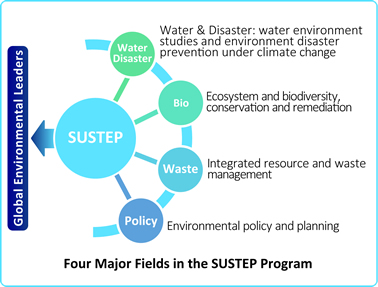
Our Educational Principles
| 1. |
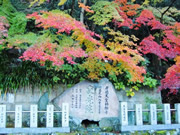
Japanese maple leaves paints landscapes in autumn |
| 2. | Foster problem-solving skills: In many cases, environmental problems always pose new problems that cannot be solved through a certain standardized solution methodology. In facing various challenges, refined problem-solving skills are important in finding solutions. The Environmental Sciences Program and the Sustainable Environmental Studies have aimed to refine these skills as one of their principal educational missions. |
| 3. | Produce cross-disciplinary environmental leaders:The Environmental Programs have aimed to provide research and education that combine both sciences and humanities. This cross-disciplinary approach is important to foster environmental leaders who are not only knowledgeable in sciences and technologies but also skilled in communication, debate and negotiation. The existing Environmental Diplomatic Leader courses provide the foundation for nourishing these cross-disciplinary skills, as the world needs more leaders who can contribute to solving environmental problems in developing countries. |
| 4. | Foster glocal visions with a good grasp of local situations: An important requirement for solving environmental problems in developing countries is the ability to grasp local situations. Based on this understanding, one needs further efforts to formulate policies/ directions by incorporating global contexts. The Environmental Sciences Program has done this applied education for more than thirty years with highly acclaimed results. |
Our Support
| 1. | SUSTEP Office:This office provides language and administrative support for those students who are enrolled in all-English degree and certificate programs. JDS fellows regularly receive important information about their curriculum and activities from this office. |
| 2. |
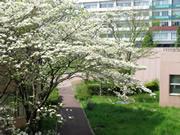
A view from the Rikakei Building |
| 3. |
On-campus Language Support:Regarding the support for international students, the International Student Center has provided courses on Japanese language and various issues in Japan. So far, most JDS fellows have taken these courses. The curriculum guidance, which is offered in April as the new academic year begins in Japan, is offered both in English and Japanese. Some compulsory courses, like Field and Laboratory Works in Environmental Sciences, consist of wide-ranging field excursions to government agencies and other places, which make it difficult to provide all-English teaching. The committee for this course, which consists of three full-time faculty members, has appointed English assistants for the JDS fellows to participate in these field excursions. |
| 4. |
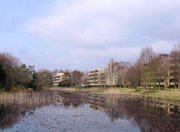
Ichinoya Residence is Every room is furnished with a bed, a table, a washbasin, a dormitory telephone and other items. Every residence complex has a laundry room and common kitchens. Also (excluding Kasuga campus) there is on-campus community center that has all the facilities necessary for day-to-day living such as a dining room, a bathhouse, a convenience store, and a beauty and hair salon. Students may also walk off-campus for other necessary goods. For more information about on-campus accommodation, please click here. |
Academic Schedule for JDS Fellows
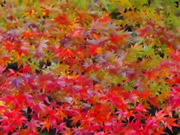 The Master's Program in Environmental Sciences has adopted an advisory committee system for the instruction of individual study/research. The standard period for the completion of the master's program is two years, which consists of six terms. The following is the academic schedule that applies to JDS fellows:
The Master's Program in Environmental Sciences has adopted an advisory committee system for the instruction of individual study/research. The standard period for the completion of the master's program is two years, which consists of six terms. The following is the academic schedule that applies to JDS fellows:
| ENTRANCE (October) |
| FIRST YEAR Pre-admission guidance (curriculum, campus life, etc.) Domestic internship for all JDS fellows (September) Fall semester (October-March): -Officially register academic supervisor and research topic -Register and take compulsory and elective courses in English -Presentation on one’s research background at individual laboratory seminars -Attend the annual JDS International Seminar (November-December) -Participate in other JDS domestic internships/academic conferences -If necessary, conduct field surveys under the guidance of one’s supervisor |
| SECOND YEAR Spring semester (April-September): -New budget year JDS special program guidance for all JDS fellows -Continue to take courses that are relevant to JDS fellow’s research interests -Presentation and thesis study on the research topic at individual laboratory seminars -Join international internship (August) -TOEFL ITP test (August) -Participate in domestic internship for all JDS fellows (September) Fall semester (October-March): -If necessary take additional elective courses -Present research progress for all students and faculty members at Interim Oral Presentation (October) -Present at annual JDS international seminar (November or December) -Engage in thesis writing under the guidance of one’s own supervisory committee |
| GRADUATION (August/September) |
September Completion Schedule 2024
| Date (2024) | Documents to be submitted |
| May 7(Tue) | Manuscript of the conference proceedings of the Interim presentation Conference |
| May 15(Wed) | Interim presentation Conference |
| By May23(Thu) | Application for Thesis Submission |
| By Jun10(Mon) |
|
| By Jun 28 (Fri) | Manuscript of the conference proceedings of the Master’s Thesis Presentation Conference |
| Jul 10 (Wed) - Jul 25 (Thu) | Final examination |
| Jul 17 (Wed) | Master’s Thesis presentation Conference |
| Jul 10 (Wed) - Jul 25 (Thu) | Master’s Thesis (with soft binding) |
| Aug 8 (Thu) | CD-R (containing a PDF file of your thesis) |
| Sep 25 (Wed) | Graduation Ceremony |
- When you make your CD-R, all thesis contents including the cover has to be in a SINGLE PDF file.
About Our University
| 1. |
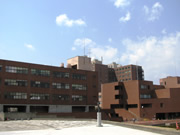
Campus's main plaza and |
| 2. |
One of leading universities in Japan:The concept of university reform still plays a major role in our continuing efforts toward improvement. We have always strived to be a unique, active, and internationally competitive university with superlative education and research facilities. Our efforts have proved to be successful as the Ministry of Education, Culture, Sports, Science and Technology, for example, recognized in its 2009 publication that the University of Tsukuba is one of the thirteen "leading universities" in Japan. As of 2010, the University has produced three Nobel Prize laureates in physics and chemistry along with many distinguished scholars in sciences and humanities. Our distinguished kinesiology and sports department has produced several Olympic medalists. |
| 3. | Location:The main campus is located north of the central Tsukuba Science City, and 60 km northeast of Tokyo (2,700 hectares). The five campus zones are linked by loop roads. A promenade called "Pede" and bicycle paths run through all five zones and reach the center of the city (As part of our effort to be environmental friendly, campus members are encouraged to commute by bus or bicycle). Downtown Tsukuba or "Tsukuba Center" is connected to Tokyo by train and bus. Via the rapid service of the TX Tsukuba line, it takes 45 minutes between the Tsukuba station and Akihabara station, a hub of electronic products. There are also direct bus services to Narita (Tokyo) International Airport (about 100 minutes) and Haneda Domestic Airport (80 minutes) as well as the Ibaraki Airport and Mito City. |
| 4. | 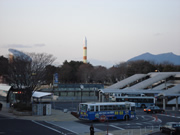
Downtown Tsukuba |
| 5. | A hub of industrial innovation: The University of Tsukuba has an on-campus industrial liaison center, which facilitates R&D cooperation between academic institutions and a number of on-campus venture companies. As of 2024, the University had launched about 230 businesses. (e.g., software, biomass conversion substances of biological resources, and medical analysis equipment) The university also has 30 inter-departmental education institutes, including the Center for Tsukuba Advanced Research Alliance (TARA), the Agricultural and Forestry Research Center, the Terrestrial Environment Center, the Shimoda Marine Research Center, and the Gene Research Center. |
| 6. | More than 40 years of our commitment to environmental sciences:Another distinctive characteristic of the University of Tsukuba is its long commitment to environmental studies. The University established the Master's Program in Environmental Sciences in 1977, which was the first attempt among Japanese universities to provide graduate education for environmental studies. The Program has emphasized the concept of symbiosis with nature by reducing environmental burdens. It still exists today and admits about ninety to one hundred students each year. |
About Our Graduate School
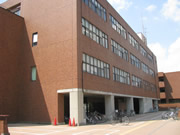
Our Rikakei Building where
most of classes are held
The Graduate School of Life and Environmental Sciences was established in 2000 by incorporating five preexisting graduate programs such as Structural Biosciences, Functional Biosciences, Appropriate Technology and Science for Sustainable Development, Biosphere Resource Science and Technology, and Life Sciences and Bioengineering. The founding concept was to nurture researchers and train practicing professionals in the field of basic, applied and interdisciplinary studies in earth, life and environmental sciences.
Since then, the Graduate School has expanded by adding more programs, including the Master's Program in Environmental Sciences and the Doctoral Program in Sustainable Environmental Studies. These programs have uniquely merged science-technology studies (e.g., bio-resources recycling, environmental microbiology, environmental disaster prevention, hydrology, meteorology, public health, remote sensing, soil resource management, urban planning, waste management, water treatment) along with arts and humanities that are related to human development, economics, environmental ethics, law, policy evaluation, and ethnohistory. The strength of these programs is also seen in their diverse field-oriented practicum studies in Japan and overseas.
Since 2007, the Graduate School of Life and Environmental Sciences has offered ten doctoral programs, one five-year doctoral program, and four master's programs with more than two hundred full-time faculty members. Of these programs, the Master's Program in Environmental Sciences has accepted JDS fellows since 2007. As interdisciplinary education/ research, international cooperation and international competency are important features of this Graduate School and the University at large, JDS fellows are able to take English courses on wide-ranging topics that are offered by not only the Graduate School of Life and Environmental Sciences but also other graduate schools.







